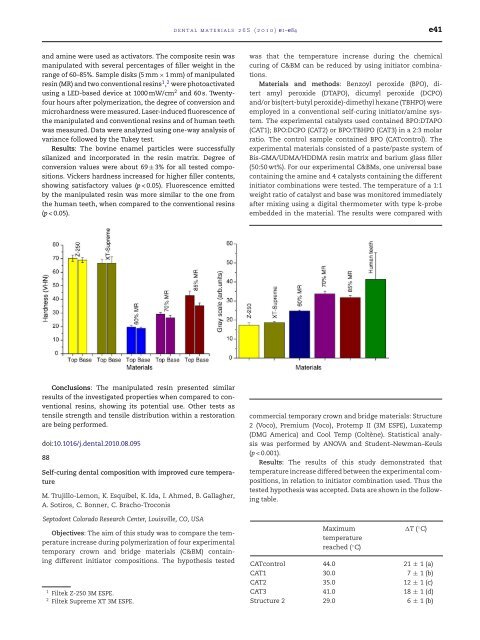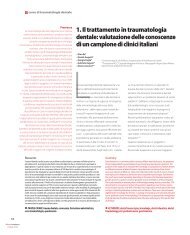Abstracts of the Academy of Dental Materials Annual ... - IsiRed
Abstracts of the Academy of Dental Materials Annual ... - IsiRed
Abstracts of the Academy of Dental Materials Annual ... - IsiRed
You also want an ePaper? Increase the reach of your titles
YUMPU automatically turns print PDFs into web optimized ePapers that Google loves.
and amine were used as activators. The composite resin was<br />
manipulated with several percentages <strong>of</strong> filler weight in <strong>the</strong><br />
range <strong>of</strong> 60–85%. Sample disks (5 mm × 1 mm) <strong>of</strong> manipulated<br />
resin (MR) and two conventional resins 1 , 2 were photoactivated<br />
using a LED-based device at 1000 mW/cm 2 and 60 s. Twentyfour<br />
hours after polymerization, <strong>the</strong> degree <strong>of</strong> conversion and<br />
microhardness were measured. Laser-induced fluorescence <strong>of</strong><br />
<strong>the</strong> manipulated and conventional resins and <strong>of</strong> human teeth<br />
was measured. Data were analyzed using one-way analysis <strong>of</strong><br />
variance followed by <strong>the</strong> Tukey test.<br />
Results: The bovine enamel particles were successfully<br />
silanized and incorporated in <strong>the</strong> resin matrix. Degree <strong>of</strong><br />
conversion values were about 69 ± 3% for all tested compositions.<br />
Vickers hardness increased for higher filler contents,<br />
showing satisfactory values (p < 0.05). Fluorescence emitted<br />
by <strong>the</strong> manipulated resin was more similar to <strong>the</strong> one from<br />
<strong>the</strong> human teeth, when compared to <strong>the</strong> conventional resins<br />
(p < 0.05).<br />
Conclusions: The manipulated resin presented similar<br />
results <strong>of</strong> <strong>the</strong> investigated properties when compared to conventional<br />
resins, showing its potential use. O<strong>the</strong>r tests as<br />
tensile strength and tensile distribution within a restoration<br />
are being performed.<br />
doi:10.1016/j.dental.2010.08.095<br />
88<br />
Self-curing dental composition with improved cure temperature<br />
M. Trujillo-Lemon, K. Esquibel, K. Ida, I. Ahmed, B. Gallagher,<br />
A. Sotiros, C. Bonner, C. Bracho-Troconis<br />
Septodont Colorado Research Center, Louisville, CO, USA<br />
Objectives: The aim <strong>of</strong> this study was to compare <strong>the</strong> temperature<br />
increase during polymerization <strong>of</strong> four experimental<br />
temporary crown and bridge materials (C&BM) containing<br />
different initiator compositions. The hypo<strong>the</strong>sis tested<br />
1 Filtek Z-250 3M ESPE.<br />
2 Filtek Supreme XT 3M ESPE.<br />
dental materials 26S (2010) e1–e84 e41<br />
was that <strong>the</strong> temperature increase during <strong>the</strong> chemical<br />
curing <strong>of</strong> C&BM can be reduced by using initiator combinations.<br />
<strong>Materials</strong> and methods: Benzoyl peroxide (BPO), ditert<br />
amyl peroxide (DTAPO), dicumyl peroxide (DCPO)<br />
and/or bis(tert-butyl peroxide)-dimethyl hexane (TBHPO) were<br />
employed in a conventional self-curing initiator/amine system.<br />
The experimental catalysts used contained BPO:DTAPO<br />
(CAT1); BPO:DCPO (CAT2) or BPO:TBHPO (CAT3) in a 2:3 molar<br />
ratio. The control sample contained BPO (CATcontrol). The<br />
experimental materials consisted <strong>of</strong> a paste/paste system <strong>of</strong><br />
Bis-GMA/UDMA/HDDMA resin matrix and barium glass filler<br />
(50:50 wt%). For our experimental C&BMs, one universal base<br />
containing <strong>the</strong> amine and 4 catalysts containing <strong>the</strong> different<br />
initiator combinations were tested. The temperature <strong>of</strong> a 1:1<br />
weight ratio <strong>of</strong> catalyst and base was monitored immediately<br />
after mixing using a digital <strong>the</strong>rmometer with type k-probe<br />
embedded in <strong>the</strong> material. The results were compared with<br />
commercial temporary crown and bridge materials: Structure<br />
2 (Voco), Premium (Voco), Protemp II (3M ESPE), Luxatemp<br />
(DMG America) and Cool Temp (Coltène). Statistical analysis<br />
was performed by ANOVA and Student–Newman–Keuls<br />
(p < 0.001).<br />
Results: The results <strong>of</strong> this study demonstrated that<br />
temperature increase differed between <strong>the</strong> experimental compositions,<br />
in relation to initiator combination used. Thus <strong>the</strong><br />
tested hypo<strong>the</strong>sis was accepted. Data are shown in <strong>the</strong> following<br />
table.<br />
Maximum<br />
temperature<br />
reached ( ◦ C)<br />
�T ( ◦ C)<br />
CATcontrol 44.0 21 ± 1 (a)<br />
CAT1 30.0 7 ± 1 (b)<br />
CAT2 35.0 12 ± 1 (c)<br />
CAT3 41.0 18 ± 1 (d)<br />
Structure 2 29.0 6 ± 1 (b)



